
VIII) Turbidite Systems Classification
Taking into account the causes of turbidite currents, it is utopian to propose an unique model to explain the turbidite deposits, particularly when they are studies at different scales. However, two chiefly turbidite geological models, proposed by Vail (1977, 1989, 1991) and Mutti (1977, 1992), explain the majority of the turbidite deposits found in petroleum exploration. Vail's turbidite model (see below) explains primarily the turbidite deposits triggered by regional or global relative sea level falls, while Mutti's turbidite model (see below) explains better those associated, mainly, with slope failures and catastrophic floods.
In these notes, what we call Vail's turbidite model, in opposition to Mutti's turbidite model is part of the sequence (or sequential) stratigraphy approach proposed by the Exxon team in the 70s and 80s. In fact, in sequential stratigraphy, the major factor driving the cyclicity of the sedimentary deposits is, among others (subsidence, terrigeneous influx, climate), the eustasy, i.e., the sea-level changes (relative and global). Such conjecture, which was previously advanced by : (i) De Maillet, 1748 ; (ii) Lavoisier, M., 1793 ; Lemoine, 1911 ; Burollet, P.F., 1954 ;etc. etc.), is corroborated by the recognition and mapping, on the ground and seismic lines, of stratigraphic intervals bounded by unconformities, that is to say, limited by erosional surfaces formed primarily in response to an increase in the rate of sea-level fall or to a decrease in the rate of subsidence.
A.1) Sequential Stratigraphy Review
Eustatic unconformities, which are relatively insensitive to sediment supply, are correlative, or nearly correlative, in all basins connected with the open ocean. They are, also, independent of the rate of subsidence or sediment supply in a given basin, whether sea-level varies rapidly or at rates comparable to typical rates of tectonic subsidence (not all geoscientists agree with such conjectures). Subsequently, the unconformities were used to define the four chief types of stratigraphic cycles (plate below) composing the stratigraphic records (Duval, B., et al. 1993):
1) Continental encroachment cycles ;
2) Continental encroachment subcycles ;
3) Sequence-cycles and
4) Parasequence-cycles.
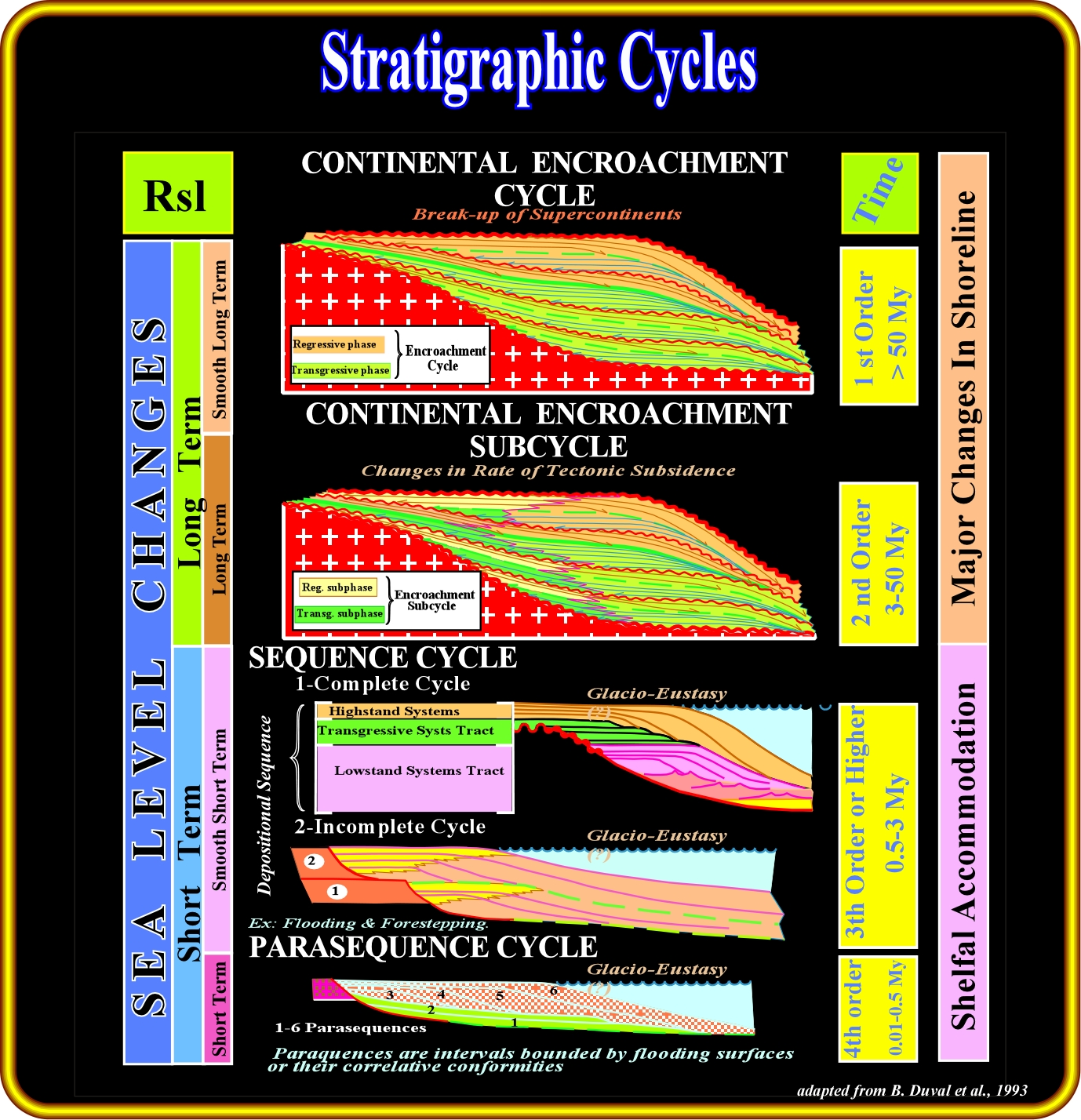
The limits bounding these stratigraphic intervals are unconformities. As pointed out, previously, and as illustrated on the plate above (hierarchy), in these notes, we will restrict the term sequence to sequence-cycle, that is to say, the stratigraphic cycle developed during a 3rd order eustatic cycle, which Exxon's geoscientists characterized by a duration-time ranging between 0.5 and 3-5 My. In this stratigraphic cycle classification, the terms supersequence and megasequence, proposed by Exxon, were discarded to avoid misinterpretation. In fact, a supersequence or a megasequence, in the Exxon terminology, are not sequences with outstanding qualities or/an exceptionally large size. That means, that only within a sequence-cycle, depositional systems are easily recognized, which allows lithological predictions.
1) Continental Encroachment Cycles
Continental encroachment cycles are associated with 1st order eustatic cycles. They are characterized by a succession of coastal onlap against the cratons. They fossilize the unconformity (erosional surface) created by the formation of Supercontinents. Two continental encroachment cycles have been deposited since the beginning of the Phanerozoic :
(a) The Paleozoic cycle ;
(b) The Ceno-Mesozoic cycle.Both cycles are recognizable in all continents. They are believed to be global. Assuming that the Latest Proterozoic represents a time of slow encroachment with regression, we can say that during the Paleozoic cycle :
- Cambrian represents the time of extensive encroachment with transgression ;
- Ordovician represents the eustatic high ;
- Silurian to Permian represents the time of restriction.
Similarly, during the Meso-Cenozoic encroachment stratigraphic cycle, one can say :
- Triassic represents a time of gradual encroachment of sediments onto the craton. Greatest thickness of non-marine sediments was deposited in grabens (rift-type basins) and bordering marine basins. This general pattern is believed to be caused by a slow relative rise of sea level due to slow long-term rise in eustasy. Non-marine rocks were widespread because the sediment supply exceeded the space being created by slow relative rise, resulting in major regression.
- Jurassic and Lower Cretaceous represent times of extensive encroachment of sediments onto the continental margins. These sediments are predominantly marine. During this time period, the average relative sea level rose more rapidly due to an increase in the rate of rise of long-term eustasy. Marine rocks are dominant. Sediment supply did not keep up with the new space being created by more rapid relative rise, resulting in overall transgression.
- Lower Turonian is believed to have been the time of the maximum eustatic high.
- Upper Cretaceous and Cenozoic are characterized by an overall gradual restriction of sediments to the continental margins and basinal areas. This pattern is believed to be caused by the slow long-term fall of the eustasy causing a decreasing relative rise and regression or relative fall and exposure.
2) Continental Encroachment Subcycles
Continental encroachment subcycles are associated with 2sd order eustatic cycles. They are characterized by unconformities induced by major basinward shifts of coastal onlap. Basinward shifts interrupt the continuity of continental encroachment associated with breakup of Supercontinents.
3) Sequence-cycles
Sequence-cycles are associated with 3rd order eustatic cycles. They are bounded by unconformities induced by changes in water depth, i.e., by accommodation changes in the margins of basins and characterized by regional onlap surfaces. They are composed by systems tracts, that is to say, by lateral linkage of contemporaneous depositional systems (different lithologies).
4) Parasequence-cycles
These cycles are associated with 4th order eustatic cycles or higher. They are bounded by two consecutive flooding surfaces.

In this geological tentative sequential interpretation of a seismic line from the North Sea line, the stratigraphic and palaeontologic results of well #A suggest that the more likely age of the unconformities, individualizing the different seismic packages, are 21 Ma, 30 Ma, 36 Ma, 39.5 Ma, 49.5 Ma and 55 Ma (millions years ago). Subsequently, the sedimentary packages are related to eustatic cycles with time-durations higher than 3-5 My. In other words, they do not correspond to sequence-cycles, but to continental encroachment subcycles within which, transgressive and regressive episodes are easily recognized. A major downlap surface separates the transgressive interval (at the bottom, in green) from the regressive interval (at the top, in orange). However such episodes do not correspond to systems tracts. The purple intervals represent sedimentary packages deposited during lowstand geological conditions, that is to say, periods of time during which the sea level was below the shelf break.
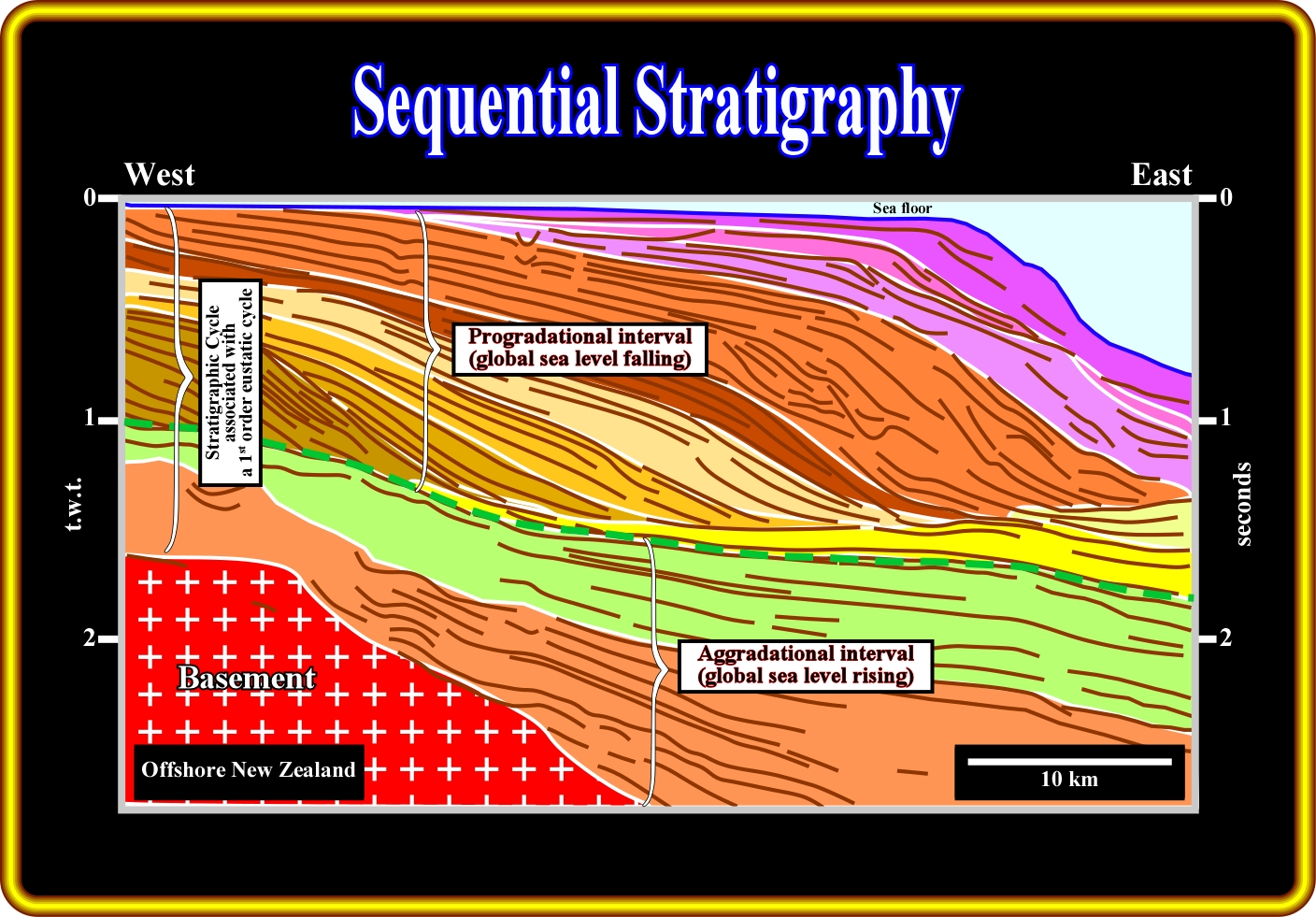
Seismic lines, as illustrated by the markers picked in this geological tentative interpretation, have confused a lot of seismic interpreters, who used super and megasequence (original Exxon terminology) to advance lithological predictions. Erroneously, they considered super and megasequences as big sequence-cycles (as a supertank is a big tank). In fact, they assumed the presence of super and megaturbidite intervals, as it is the case in a sequence-cycle. The basic Vail's depositional model, i.e., the building block of sequential stratigraphy is the stratigraphic sequence-cycle deposited, as said previously, in association with a 3rd order eustatic cycle. Such a stratigraphic sequence-cycle is composed by depositional systems tracts, which allow lithological prediction, since each deposition system is characterized by a lithology and an associated typical fauna (facies in the Gressly's sense). Lithological predictions can be only advanced when seismic interpretation is performed at high hierarchical level. Stratigraphic cycles associated with 2nd and 1st order eustatic cycles, as illustrated, in this geological tentative interpretation, are composed by an aggradational (global sea level rising) and a progradational interval (global sea level falling), in which several high hierarchical stratigraphic intervals (sequence-cycles) can be recognized.
Sequence-cycles, i.e., stratigraphic cycles deposited during third order eustatic cycles (time-duration ranging from 0.5 My to 3-5 My), are considered as the building blocks of the sequential stratigraphy. When complete, they are composed of three systems tracts (lateral linkage of coeval depositional systems). In fact, from top to bottom, within a sequence-cycle, quite often, one can distinguish:
- Highstand Systems Tract (HST),
- Transgressive Systems Tract (TST),
- Lowstand Systems Tract (LST).
The highstand systems tract (HST) has a progradational geometry (forestepping, outbuilding). The upper limit is always a sequence-cycle boundary. The lower limit is often the maximum flooding surface of the underlying transgressive systems tract, but, in certain cases, it can be also a sequence-cycle boundary. The log pattern is typical of a coarsening and thickening upward interval.
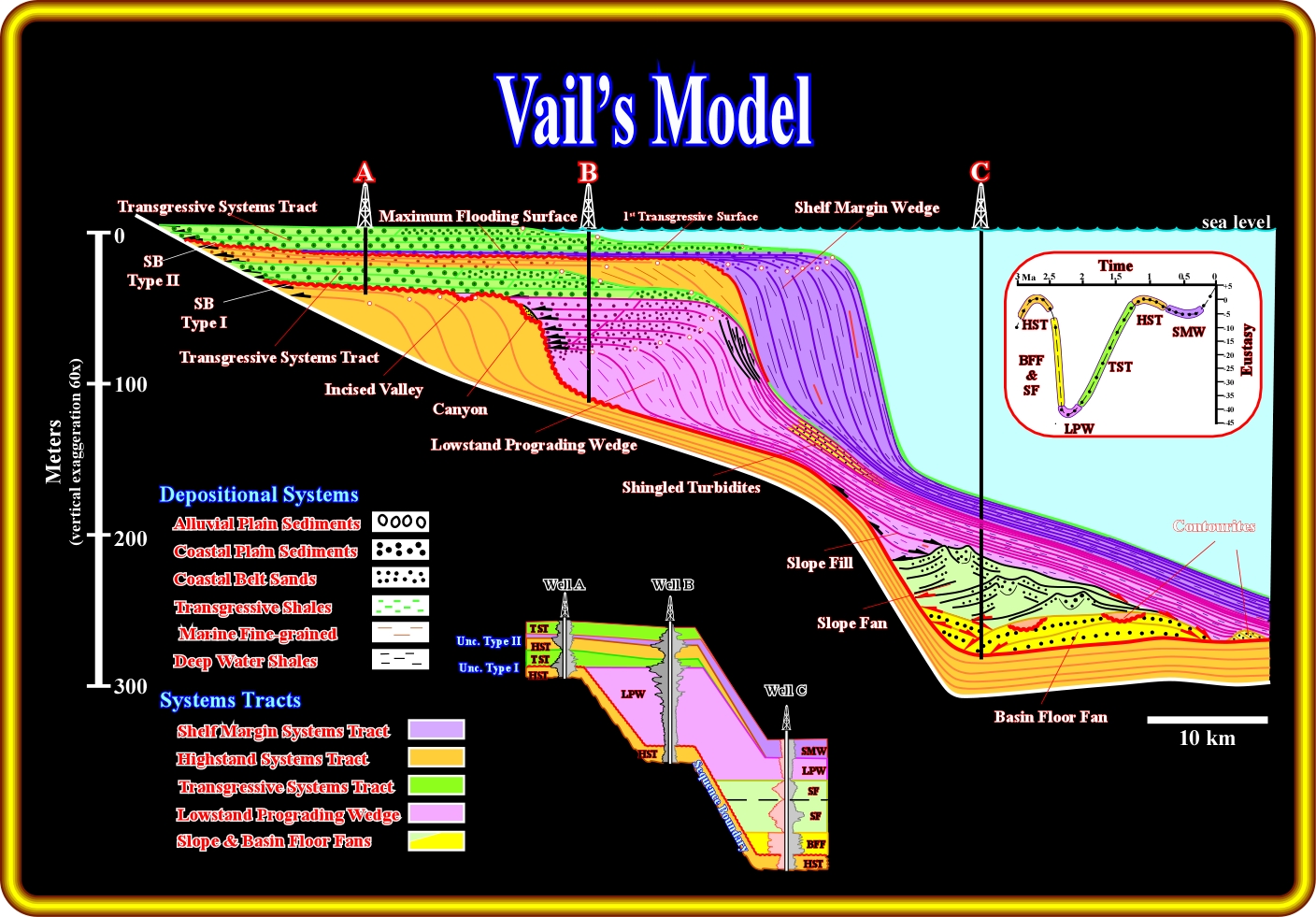
This figure summarizes the basic principles of Vail's sequential stratigraphy when performed at the hierarchic level of sequence-cycles. In fact, the stratigraphic cycles, deposited during 3rd order eustatic cycles, which have a time-duration ranging between 0.5 and 3-5 Ma, are bounded by unconformities and composed of three main depositional systems tracts. On the other hand, as depicted, depositional systems tracts are clearly related with depositional environments. In fact, landward of the shelf break, a well (A) recognizes just the transgressive and highstand systems tracts. In deep water, the lowstand systems tract (basin floor fans, slope fans and lowstand prograding wedge) is predominant, while the transgressive and highstand systems tracts are quite condensed.
The transgressive systems tract (TST) has a overall retrogradational geometry (backstepping). The lower limit is, generally, a flooding surface (1st transgressive surface), but, in certain geological conditions, it can be a sequence-cycle boundary. The upper limit is generally a maximum flooding surface, but a sequence-cycle boundary cannot be excluded, particularly when a relative sea level fall takes place following an expected tectonic event.
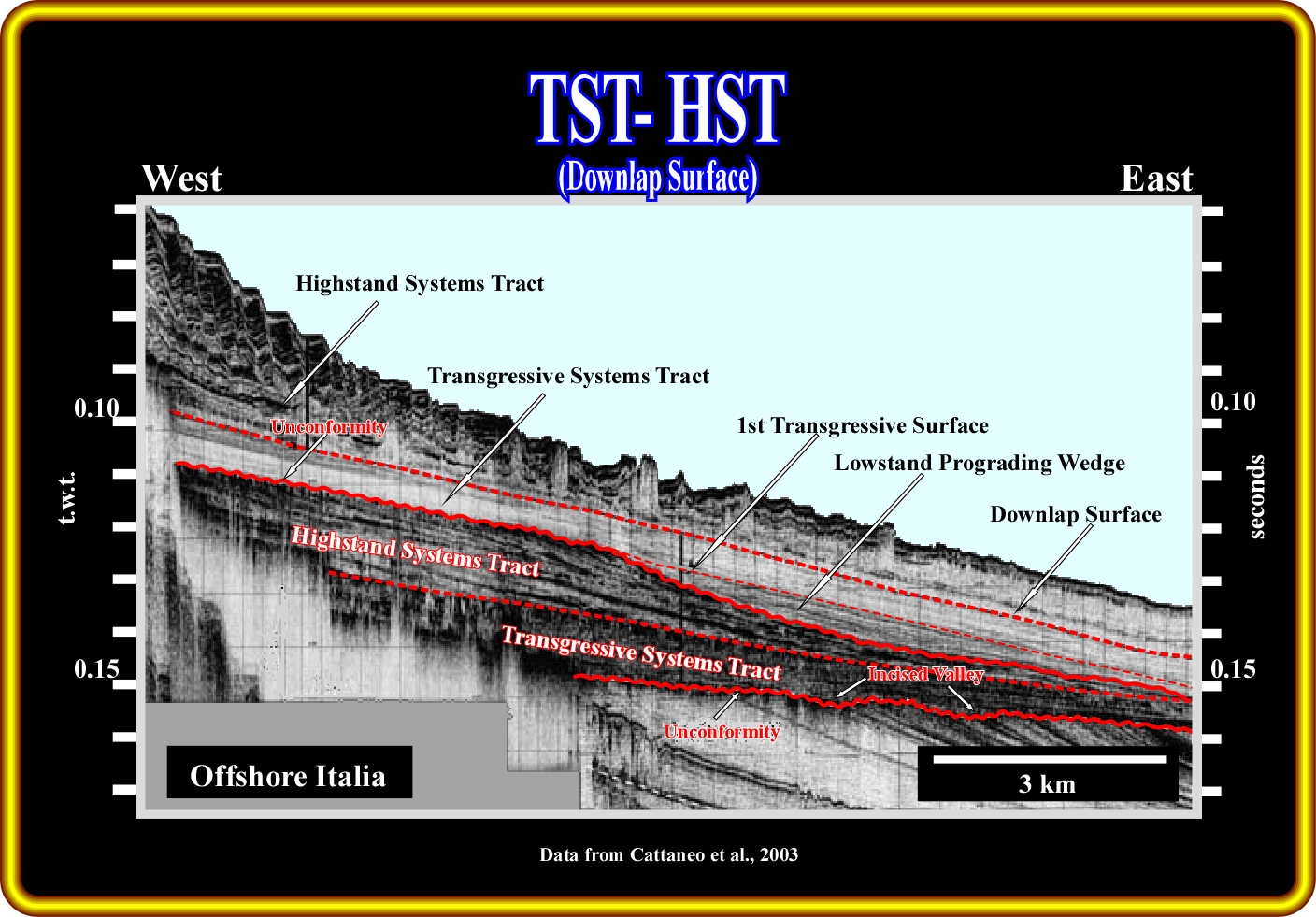
On this seismic line, the downlap surface separating the transgressive systems tract, which geometry is overall retrogradational (backstepping), from the forestepping highstand systems tract is clearly visible. Similarly, incised valleys are visible along the lowermost unconformity, which separates an old highstand systems tract from a younger transgressive systems tract. It is interesting to note the scale of this seismic line. The time thickness of the upper sequence-cycles (two incomplete sequence-cycles) is roughly 30-40 milliseconds, that is to say, around 20-30 meters. In fact, on seismic data, usually, a sequence-cycle interpretation requires high-resolution data or quite thick depocenters in which, generally, the thickness of the stratigraphic intervals is above the seismic resolution. In particular depocenters, as illustrated in next plate, the rate of deposition is so high that several sequence-cycles can be deposited in time-interval lower that 3-5 My. Nevertheless, one can say that in the field a sequence-cycle interpretation is viable, but on conventional seismic data, it is, normally, not feasible.
As illustrated in above and below plates, the typical backstepping geometry of a transgressive systems tract is, in fact, apparent. It corresponds to a stacking of regressive episodes that progressively prograde less and less. In other words, at each sea level rise increment (flooding), the depositional coastal break (roughly the shoreline) is displaced further landward, creating a ravinment surface at the top of the already deposited sediments. Then, as sediments are deposited, the depositional coastal break is progressively displaced seaward, but without reaching the position that it had before the rise of sea level took place. A new increment of sea level rise increases the shelfal accommodation displacing again the depositional coastal break landward and creating another ravinment surface. Then, again, deposition takes place and the depositional coastal break is progressively displaced seaward.

On this geological tentative interpretation of a seismic line from offshore Kalimantan (Indonesia), where the rate of sedimentation is quite large, the picking of the boundaries of the stratigraphic sequence-cycles and depositional systems tracts, for the more evident and calibrated sequence-cycle,s is illustrated. The majority of the picked sequence-cycles are complete, that is to say, that they are composed by the three depositional systems tracts : (i) Highstand Systems Tract (HST) ; (ii) Transgressive Systems Tract (TST) and (iii) Lowstand Systems Tract (LST). Notice, that that between sequence-boundaries 5.5 Ma and 8.2 Ma, taking into account reflections terminations, it is possible to interpret high frequency sequence-cycles. In other words, in a time-interval lower than 3 My, there are more than one sequence-cycle.
The lowstand systems tract (LST) has an overall progradational geometry. From bottom to top, generally, three stratigraphic members can be distinguished :
(i) Basin floor fan (BFF) ;
(ii) Slope fan (SF) ;
(iii) Lowstand prograding wedge (LPW).
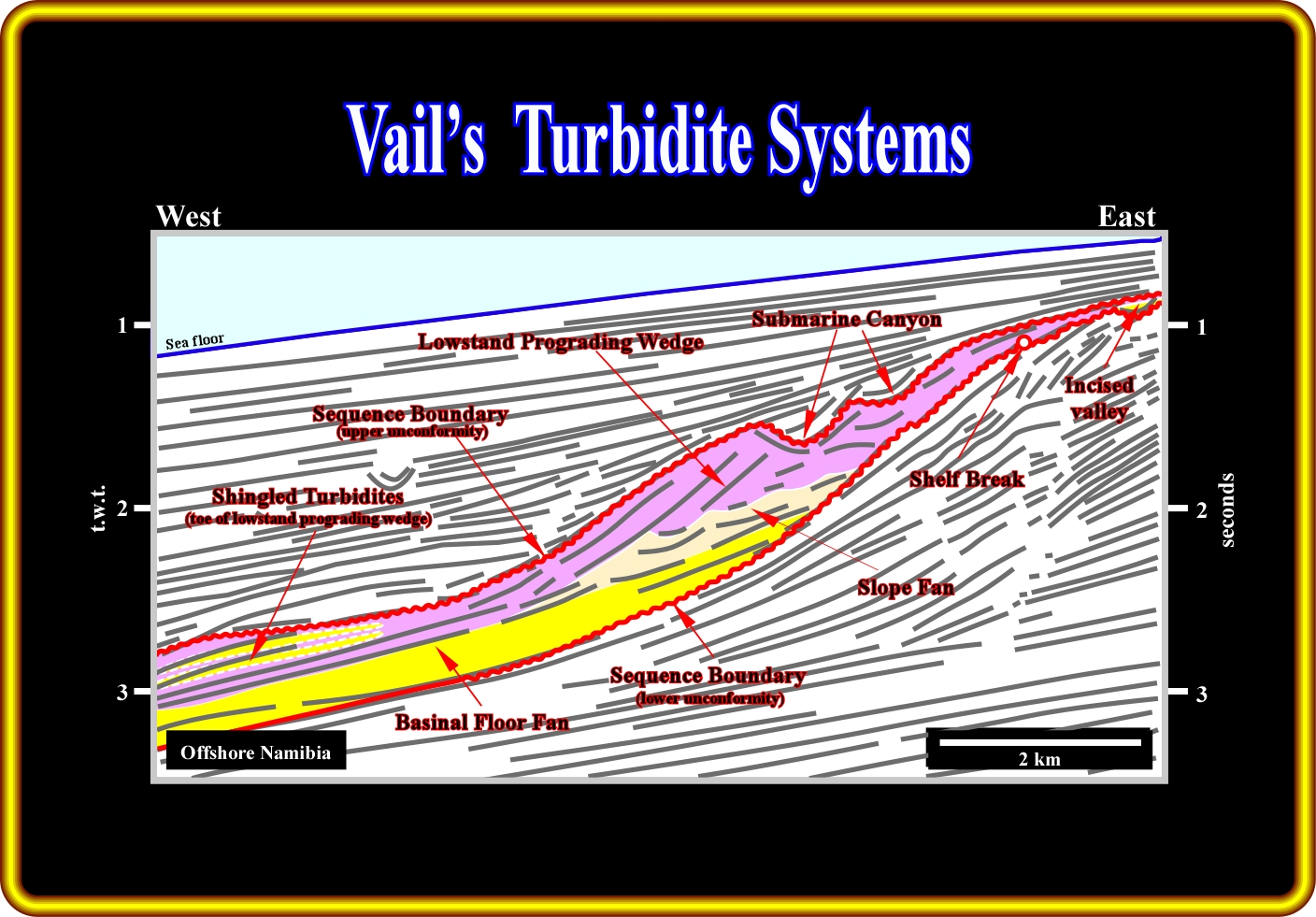
On this geological tentative interpretation of a seismic line from Namibia offshore, a sequence-cycle (between the red lines) is just represented by the lowstand systems tract (LST), in which the three members, composing it, are easily recognized not only by their stratigraphic positions but reflections terminations as well. In fact, just above the lower sequence-cycle boundary, characterized by an onlap seismic surface and the infilling of an incised valley, landward of the shelf break, the basin floor fan (BFF) is recognized by its parallel geometry. Overlying the proximal area of the basin floor fan, a slope fan (SF), with its channel-levee complex geometry, is fossilized by a lowstand prograding wedge characterized, mainly, by a sharp forestepping geometry with shingled turbidites at the toe of the progradations. Submarine canyons in the upper slope enhance the upper boundary of this incomplete sequence-cycle.
Basin floor fans are located seaward of the toe of the continental slope. Slope fans are located in lower-upper slope and attached to the toe of the continental slope. Lowstand prograding wedges are located between the shelf break (lower sequence-cycle boundary) and the toe of the continental slope. Quite often, at the toe of the progradational lowstand prograding wedge (LPW), shingled turbidites are deposited. Seaward of the toe of the continental slope, lowstand prograding wedges are represented mainly by stratigraphic condensed sections.
Send E-mail to carloscramez@gmail.com with critics, corrections or commentaries on these Turbidite Deposits notes.
Copyright © 2001CCramez
Last modification : November, 2013